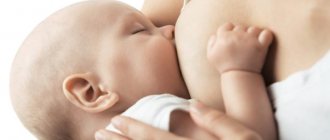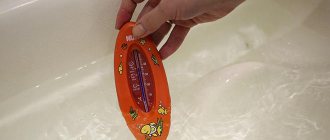Aqua calculator
Water calculator - calculate how much water your child needs.
Water is the basis of life and a natural component of the human body. Children's bodies especially need proper water consumption. After all, it is at an early age that the most important stages of development of the nervous, circulatory, respiratory, digestive and immune systems of the body occur.
A child’s proper diet is the basis of his health and further development.
And the sooner you help your child form the habit of proper water consumption, the easier it will be for him to maintain a healthy and proper lifestyle in the future. A child's body is 80% water, and an adult's body is 60%. So, let’s figure it out: how much water is needed for the healthy development of a child’s body, what kind of water is healthy, and how often should the child be offered a drink?
Expert opinion
Belmer Sergey Viktorovich answers these and other important questions on the topic
, Doctor of Medical Sciences, Professor of the Department of Hospital Pediatrics No. 2 of the Faculty of Pediatrics of the Russian National Research Medical University (RNRMU) named after. N.I. Pirogov.
Let's debunk the most popular myths about water, that is, the most popular misconceptions about its benefits, quantity, quality, and possible harm.
Every baby has different needs – why?
Some kids drink willingly and a lot, while others sometimes categorically refuse water. When trying to answer the question “How much water should I give my child?”, it is important to take into account his individual needs, which may depend on the following factors:
- lifestyle;
- metabolic features;
- type of food;
- ambient temperature;
- motor activity.
For example, if the baby is exclusively breastfed, then the need to drink water separately will be minimal, because mother’s milk already consists of 85% water.
Therefore, according to experts, such children are already provided with all the necessary nutrients. It is believed that in most cases, before reaching six months of age, there is no need for the baby to drink water.
However, it is worth noting that in practice, in the first months of life, the baby may still need drinking water. Most often this is due to hot weather (when the baby’s appetite decreases, but thirst, on the contrary, increases), dry air in the room. Also, an important factor influencing how much water a child should drink per day can be the nursing mother’s consumption of fatty, spicy and sweet foods. Supplementation is necessary when the baby gets sick, in particular if he is suffering from fever, vomiting, and diarrhea. If the child is constantly restless and refuses to breastfeed, try giving him a little water - 1 teaspoon: if he drinks willingly, it means he needs such a drink (we are talking exclusively about water intended specifically for children).
If the child has already grown up, eats and drinks on his own, you must properly organize a balanced diet for him, exclude dry snacks, which also determine how much water he drinks. But remember: if your baby asks to drink too often, this may be a warning sign, so at the first suspicion you should consult a doctor.
Myth #1: It is necessary to give your baby extra water from the moment of birth.
It's a delusion. It all depends on the specific situation, whether the baby is breastfed or not. How much and how often does the baby consume breast milk or formula per day? At each age, water needs are different. See for yourself:
Standards for children's total daily water needs
| Child's age | Water requirement per 1 kg. body weight |
| 1 day | 90 ml |
| 10 days | 135 ml |
| 3 months | 150 ml |
| 6 months | 140 ml |
| 9 months | 130 ml |
| 1 year | 125 ml |
| 4 years | 105 ml |
The table values take into account all the water that the child receives during the day. This includes clean water, various drinks, soups, and solid foods that also contain water.
Based on the data presented in the table, you can easily calculate the child’s need for clean water. So, for example, let’s take a baby weighing 3 kilograms. According to the table, we calculate the daily water requirement of a baby: 3 kg * 90 ml = 270 ml/day. If you know how much water from milk or complementary foods a child receives per day, it is not difficult to calculate whether the baby needs to give additional water.
As a rule, a breastfed baby up to six months old needs enough water from mother's milk and does not require additional water intake. When introducing complementary foods, it is necessary to give the child additional water.
But once again I would like to remind you that the rate of water consumption is a purely individual value, which depends on the child’s activity, the biochemical characteristics of the child’s body, and the temperature and humidity of the surrounding air.
Existing standards
How do you know how much water a newborn baby should drink? In most cases, we are talking about compliance of fluid intake with WHO recommendations. Namely, a certain standard has been established for infants under 6 months. Breastfed children need supplemental feeding only in extreme cases - when they lose fluid during illness (diarrhea, elevated body temperature), in the heat. For those who receive artificial nutrition, it is recommended to give up to 150 ml additionally during the day. When solid foods are introduced into the diet, the amount of water in the diet increases. A simple formula will help you calculate the standard yourself. First, the baby’s body weight needs to be multiplied by 50. The resulting number (for example, 8x50 = 400 ml) will be needed for further calculations. Next, the amount of liquid nutrition consumed by the baby is taken into account. Multiply 300 ml of milk, soup, mixture by a factor of 0.75. The resulting number is 225 ml, subtracted from the previously obtained amount of 400 ml. The difference will correspond to the volume of additional soldering.
Everything is clear with babies, but how much water should a child drink at 2 years old? On average, consumption volumes can reach from 800 to 1500 ml, depending on the baby’s activity and external temperature. Consider everything your baby consumes: soup, tea, juices. It is possible that he drinks a small amount of water due to the fact that he replenishes fluid losses by other means.
How much water should a 5 month old baby drink if the summer heat threatens him with heatstroke? Even a baby in this situation can be offered about 50 - 100 ml, and for bottle-fed children this volume can be increased. Accordingly, you can decide how much water a child should drink at 8 months.
Schoolchildren of primary and secondary classes are equal to adults in terms of consumption standards.
Myth #2: Bottled water still needs to be boiled.
Bottled water does not need to be boiled. The technology of water preparation and bottling ensures its sterility throughout its shelf life. In this regard, boiling, aimed specifically at destroying microorganisms in water, is not required in this case. In all other cases, such as water from the tap, spring, well, etc., it is necessary to boil. And sometimes more serious methods of treating such water are required, but it is not recommended to give such water to children.
BabyMother
Contents [Show]
Water is such a necessary product; from early childhood, a person needs a large amount of liquid so that he grows and develops harmoniously. Therefore, immediately after the birth of a child, young mothers wonder how and when to start giving water to their baby, and whether the baby even needs additional liquid besides milk.
Water carries life, and, accordingly, the role of this liquid in people’s lives is not exaggerated:
- Voditsa actively participates in every metabolic process occurring in the body.
- Regulates body temperature.
- Delivers nutrients and minerals dissolved in it to cells and tissues.
- Metabolic products are removed from the body with excess fluid.
- In addition, it is a source of all necessary mineral salts and fluorine.
A person consists of approximately 80% water, which is why water is so necessary for the full development of a child’s body.
But not all water is healthy. The water that comes out of the water supply may contain various bacteria, radionuclides, heavy metals and other substances that are toxic and harmful to adults, and especially to children. She can't give small children anything to drink!
How to properly purify water?
Read more…
Go to description...
The health of the child is one of the main concerns of parents. Did you know that water plays a key role in the formation of a child’s body and strengthening the immune system? In this article we will tell you how much of this life-giving liquid it is advisable for children of different ages to drink per day and why it is important.
Science has long proven the enormous importance of drinking the required amount of water per day. And this is not surprising. Thus, a child’s body is 80% water, and an adult’s body is 60%. Water is easily absorbed by the body and has a strong influence on all processes occurring in it. Its lack leads to poor health, decreased immunity and even weight gain. Often, the development of certain diseases is just a signal that our body does not have enough water! This liquid plays a particularly important role for children's health. And the sooner you help your child form the habit of drinking water competently, the easier it will be for him to maintain a healthy lifestyle as an adult.
As we have already said, water has a beneficial effect on health and is involved in vital processes. Its regular use improves metabolism, maintains blood pressure and body temperature, reduces the risk of allergic reactions and even improves mood. Dehydration leads to rapid fatigue, tiredness, and the development of a number of diseases. Lack of water is especially dangerous at elevated body temperatures and on hot days.
Here is just a small list of health problems that can result from lack of water:
- Infections and allergic reactions;
- Dry skin;
- Stones in the kidneys;
- Problems with digestion and metabolism;
- Pain in joints and back;
- Problems with teeth and gums.
In a word, water is a natural component of our body. For children, the correct regimen and volumes of consumption of this liquid play an extremely important role, since it is at this age that all body systems are formed. And the sooner your child learns to drink water regularly, the less often you will visit the doctor.
The health and well-being of your child will depend on what kind of water you give your child. Naturally, ordinary untreated tap water is out of the question, even if it is boiled. Water from wells or pump rooms, as well as bottled water for adults, will not work either. The thing is that children's drinking water and even water for preparing baby food are subject to special regulatory requirements, which are contained in SanPiN 2.1.4.1116-02.
In addition, the indicators of baby water must comply with the following standard values:
| Index | Normative value |
| Salt mineralization | 250-500 mg/l |
| Iodide ions | 0.04 – 0.06 mg/l |
| Fluoride ions | 0.6 – 1 mg/l |
| Potassium | 2 – 20 mg/l |
| Calcium | 25 – 80 mg/l |
| Bicarbonates | 30 – 400 |
| Rigidity | 1.5 – 7 mEq/l |
| Alkalinity | 0.5 – 6.5 mEq/l |
If you prefer bottled baby water, be sure to read the label. The latter must indicate the type of water, its category, state registration information, chemical and physiological composition, storage conditions, date of manufacture, expiration date and place of collection.
Unfortunately, the quality of children's bottled water leaves much to be desired. Thus, according to recent research by the non-profit organization Roskontrol, out of 12 brands of popular children's water analyzed, only 3 passed the tests. In the remaining samples, an increased content of ammonia and microorganisms was found, and an unbalanced salt composition was revealed.
This is why many experts recommend giving children water purified in household filters designed specifically for children. Moreover, the use of the latter often guarantees not only the removal of microorganisms and excess salts, but also the enrichment of water with microelements so necessary for the child, such as fluorine and magnesium. The latter are extremely necessary for a child from the age of three.
How much water does a child need to drink? The consumption rate will depend on age, weight, mobility, physical condition and even weather conditions.
Babies up to 4-6 months, as a rule, receive all nutrients - including water - from their mother's milk. During this period, doctors do not recommend giving babies water. First of all, because it is at this time that the intestinal flora is formed and any intervention can affect the process. Moreover, water fills the stomach and gives a false feeling of fullness - because of this, the baby may not finish eating.
Mother's milk adapts perfectly to the baby's needs. And if the baby is hot, he is more often attached to the breast and as a result receives a lot of “foremilk”, which is 88-90% water.
It is important that the mother herself consumes the required amount of water and does not feel thirsty!
However, some experts allow giving a little water on a spoon from three months - but only in hot weather, when the child is sweating or his mouth is dry. There is no need to force it, just offer it. And this should be done between feedings. Water can also be offered in the following cases:
- Constipation;
- diarrhea or vomiting;
- Hiccups;
- Fever.
But again, this must be done carefully, without persistence.
But if the child is on artificial or mixed feeding, then water must be used to prepare formulas and additionally given between feedings from the first day. But remember, the baby can drink no more than 100-200 ml per day.
In general, children under one year old need 50 ml of water per kilogram of weight, but do not forget that they get approximately 75% of water from milk and food. Therefore, in order to calculate how much of this life-giving liquid is needed to maintain water balance, one should subtract from the daily requirement (50 ml, multiplied by the child’s weight) the amount of water received with food (milk drunk in ml, multiplied by 0.75).
When solid foods are introduced into the diet, the need for water increases. At the same time, children begin to move actively, so fluid loss increases. You can calculate the daily water requirement using the same scheme: a child needs 50 ml of water per kilogram of weight. In this case, we are talking specifically about pure still water: juices, compotes, tea and other similar drinks are not taken into account.
Here are some signs that can help you determine that your baby is not getting enough water:
- Lips and mouth are dry;
- Skin is dry and/or pale;
- After 6-8 hours of sleep, the diaper is dry;
- The child shows anxiety, cries more often, but without tears;
- Urine is dark in color or has a strong odor;
- The child drinks water greedily.
The older the child, the more water he drinks. By school age, this volume will already reach 1.2-1.7 liters of water per day. At the same time, from the age of 4, the baby’s nervous and skeletal system begins to actively form. Therefore, it is so important that the water contains the required amount of fluoride and magnesium
During this period, it is important to teach your child to drink regularly. Care should be taken to ensure that water is always available. You can take convenient sippy bottles with you on walks.
For children with heart disease, kidney disease, or diabetes, the drinking regime must be strictly prescribed by a doctor.
From 7 years and older
At this age, the norm of water consumption is 1.7-2.5 liters of water per day. When calculating an individual value, know that it is worth taking into account your child's activity. If he plays sports and is generally physically active, then the amount of this fluid must be increased. Also keep in mind that the composition of water for children 12 years of age and older should be as close as possible to water for adults. And remember that during periods of illness or hot weather, the need for fluid increases.
Myth #3: There is no difference between “children’s” and “adult” water.
“Children’s” water has higher quality requirements and a physiologically balanced composition. Bottled water of the first and, especially, the highest category is subject to very stringent requirements for its safety, in particular, for its chemical composition. In the case of “baby” water, the requirements for its composition are even higher. During its production, it is necessary not only to prevent the concentration of macro- and microelements from exceeding, but also to ensure their balanced content, taking into account the characteristics of the child’s body.
How to understand that a child does not have enough water
To begin, carefully analyze changes in the child’s behavior, his drinking regime, daily physical activity, and frequency of urination. With a normal amount of water in the body, urine is light or transparent yellow. Its rich yellow color may indicate a lack of fluid in the body. Bright yellow indicates that the kidneys are retaining fluid to keep the body functioning.
You can offer your child to drink water when he is busy playing and, most likely, does not pay attention to thirst. Children who are fond of sports and lead an active lifestyle especially need frequent drinking, as they more actively excrete fluid through sweat.
If your child suffers from a lack of fluid in the body, this can be felt by symptoms such as dizziness, general malaise, and weakness. The skin turns pale, the child loses the strength to move, looks tired and very tired. The skin around the mouth and mucous membranes is dry.
These symptoms are noticeable if the baby is sick or not feeling well. If you notice these signs, give him water to drink, even if he doesn't feel thirsty and refuses to drink. Despite the lack of desire to drink, the body feels a lack of fluid. What should you give your children to drink besides water? You can offer your child diluted juice or compote. Green tea with a little sugar is great.
Dehydration is very dangerous for a child's body. A neglected problem can lead to the death of a baby, but this happens extremely rarely.
Myth #4: Water can easily be replaced with juices, fruit drinks and other drinks
Any drink is a source of water. However, various drinks, such as juices, fruit drinks, etc., contain other substances in addition to water, such as sugar, the excess of which may be undesirable for a child. In this regard, replacing “pure water” with other drinks must be done with great caution. After the introduction of complementary foods, juices and fruit drinks appear in the child’s diet in regulated quantities.
Signs of water deficiency
Immediately after birth, the baby does not need additional feeding. The mother should look at his condition to understand when and how much water the child needs. This period occurs when the incoming water from milk or formula becomes insufficient. The child develops symptoms:
• prolonged absence of bowel movements, hard feces; • dry mucous membranes in the mouth; • change in urination – insufficient, absent, with excessively dark urine.
They rely on the listed signs and their own feelings to give fluid to the child in a timely manner. On average, this is required by 2-4 months after birth.
Myth #7: Water with any mineral content is suitable for a child
Water contains calcium, magnesium, sodium, iodine, selenium and many other macro- and microelements that are necessary for the body. It is important that their content does not exceed permissible concentrations. On the other hand, it should be borne in mind that water is not the exclusive or even the main source of these substances: the child receives them, first of all, from other food products. However, a deficiency of certain minerals in water, which is often observed in various regions of the world, can lead to diseases. Thus, water without minerals is hazardous to health.
Is it necessary to give water to a baby at 1, 2, 3, 4 months if he feeds on mother's milk?
If the baby is breastfed, there is no need to give him additional water. But mom, on the contrary, should drink at least 2 - 3 liters of filtered water per day. This is due to the fact that he receives everything required for growth, development and normal digestion with mother’s milk. Milk is more than 80% water, the rest is nutrients. Thus, there is no need to supplement breastfeeding children with water.
In addition, unnecessary watering of a baby under the age of 5 months creates false satiety, which is why he will refuse to drink milk, that is, he will not eat enough. Such interference can negatively affect the health, as well as the growth and development of the child.
Six-month-old children can sometimes be given additional water, especially in hot climates, if he woke up at night and sweated, as well as with diarrhea, constipation, vomiting, or if he sweats profusely during the day. At the same time, you cannot force him to drink. Just offer him a spoonful of water or give him a bottle with a small amount of it. If he refuses, then he doesn’t need it. It is worth noting that you need to be careful when using a bottle to give your baby water while breastfeeding, because... this may lead to the baby's weaning from the breast prematurely.
In the summer, a child who wakes up at night should be given a spoonful of cool water if you notice that he is hot.
Myth #8: It is best to use boiled water when bottle-feeding.
It's a delusion.
It is best to use specially industrially prepared “baby” water. It is safe and has an optimal chemical composition. These are the main myths about water in terms of baby nutrition and consumption that are encountered today. To study the topic in more detail, let’s look at a few more frequently asked questions that parents of children come to us with.
What are the benefits of the minerals listed in the composition? (Ca, Mg, K, bicarbonates, sulfates, fluorides, chlorides)
Minerals in water are necessary for the normal course of metabolic processes. Calcium and magnesium are necessary for the formation of bones and the functioning of the nervous system, potassium is necessary for the normal functioning of the heart and muscles, sodium is a key factor in almost all metabolic processes. It is very important that the chemical composition of water meets the needs of the body, which is achieved by certain technological methods in the process of producing special “baby” water.
What kind of water should children under 1 year drink?
Boiled water . In most cases, parents give their child water after boiling it first. Exposure to heat is thought to kill bacteria. However, it has long been proven that boiling kills only a portion of harmful microorganisms; moreover, boiling water contains many chloride compounds that are dangerous to the health of the baby.
Natural water. When deciding what kind of water to drink for children, it is worth excluding liquid from natural sources. It is harmful due to the large number of bacteria, nitrates and other dangerous chemicals that enter the source from the ground.
Healing water. Carbonated or mineral medicinal water is absolutely not suitable for a child’s body.
Filtered water. There is no need to give children water purified in a home pitcher filter. It is suitable for adult consumption only.
Bottled water . When asked what kind of water is best for children to drink, doctors advise buying special “children’s” water. It can be found in a supermarket or pharmacy. Such a liquid is marked that it is approved by the Russian Academy of Medical Sciences. It must meet the following requirements:
- total mineral content less than 200–300 mg/liter;
- calcium less than 60 mg/liter;
- potassium less than 5–20 mg/liter;
- sodium less than 20 mg/liter;
- magnesium less than 10–35 mg/liter.
Water from “children’s” filters. You can resort to a more economical option - purchase a special children's water filter. This device is low cost and economical (one cartridge can clean 100–200 liters). The filter purifies water from mechanical impurities, chlorine, pesticides, and kills all bacteria. The product is made of high-quality plastic, safe from an environmental point of view. Children's filters are recommended by pediatricians.
You may also be interested in: Boiled water: benefits or harm for children and adults
Should you give your child something to drink after active play in the heat?
This must be done, and not only after, but also during active games in the sun or in hot weather, since with sweating water is removed from the body in significant quantities. Offer your baby water as often as possible. For a walk, it is more convenient to take special “baby” water in a bottle; it has a small volume, but sufficient even for a two- or three-hour walk.
How can parents calculate how much to give their children?
To calculate water intake, parents must consider several factors.
Among them:
- Child's age.
- Lifestyle.
- Diet.
To calculate, you can use the recommendations of doctors and nutritionists.
For example , the norm is 50 ml per 1 kg of weight for children over one year old and 200 ml of water maximum per day for babies under 12 months. But all of them are given as a guide and are not accurate data for every baby.
Children's water "FrutoNyanya" - from the first days of life!
Children's water "FrutoNyanya" is water of the highest category. Does not require boiling. The water is carefully balanced in mineral composition and is suitable even for the smallest children.
Special children's water "FrutoNyanya" is available in 0.33l, 1.5l and 5l formats
Choose the most optimal format for you. A 0.33 liter bottle is ideal for a walk. And for home use: preparing porridge, mixtures and for pouring into a children's sippy cup, water in 1.5 liter bottles will be convenient. A 5 liter canister is an excellent option for a large family or for taking the required amount of water with you to the dacha.
Water quality control is carried out at all stages of the technological process of its production in an accredited testing facility. Testing center employees take water samples at each stage of its production.
When extracting water from a well, the water treatment stage, be it purification from mechanical impurities, the stage of normalizing the composition of water in terms of the content of macro- and microelements, the ozonation process or final filtration. Also, samples are necessarily taken when water is poured into containers and packaged.
All samples undergo mandatory testing for compliance with requirements and standards. Product quality control is a continuous round-the-clock process in our center. If at least one discrepancy is detected, the batch is not allowed to be sold.
The role of water in a child's life
A child's body is 75% water. Therefore, for full growth and development, children need to drink plain drinking water every day. It is the most important participant in metabolism in the human body. Entering the body, the liquid nourishes the cells with biologically important substances and removes toxins. In addition, it participates in respiratory processes, carries out thermoregulation, saturates joint lubrication, mucous membranes and the eyeball with moisture.
Due to the presence of an aqueous environment, it is possible for nutrients to enter cells through the blood and release waste products. Through its circulation, all organs are saturated with biologically important substances, minerals and vitamins coming from the digestive system.
Recommended articles on this topic:
- How to check water quality: independently and in the laboratory
- Drinking water at home: health comes first
- Is it possible to drink tap water, and what should you be wary of?
The breakdown products of cellular metabolism are also excreted through the blood. Water makes up 90-92% of blood, which is why it is so important to consume enough of it every day. It is important for parents to know at what age and what kind of water children can drink.











